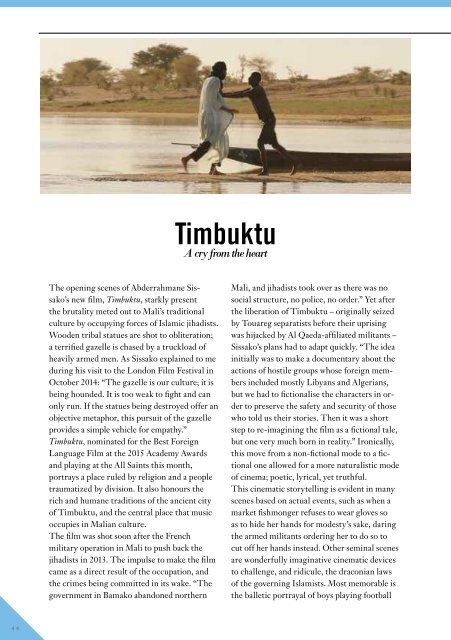You also want an ePaper? Increase the reach of your titles
YUMPU automatically turns print PDFs into web optimized ePapers that Google loves.
Timbuktu<br />
A cry from the heart<br />
The opening scenes of Abderrahmane Sissako’s<br />
new film, Timbuktu, starkly present<br />
the brutality meted out to Mali’s traditional<br />
culture by occupying forces of Islamic jihadists.<br />
Wooden tribal statues are shot to obliteration;<br />
a terrified gazelle is chased by a truckload of<br />
heavily armed men. As Sissako explained to me<br />
during his visit to the London Film Festival in<br />
October 2014: “The gazelle is our culture; it is<br />
being hounded. It is too weak to fight and can<br />
only run. If the statues being destroyed offer an<br />
objective metaphor, this pursuit of the gazelle<br />
provides a simple vehicle for empathy.”<br />
Timbuktu, nominated for the Best Foreign<br />
Language Film at the 2015 Academy Awards<br />
and playing at the All Saints this month,<br />
portrays a place ruled by religion and a people<br />
traumatized by division. It also honours the<br />
rich and humane traditions of the ancient city<br />
of Timbuktu, and the central place that music<br />
occupies in Malian culture.<br />
The film was shot soon after the French<br />
military operation in Mali to push back the<br />
jihadists in 2013. The impulse to make the film<br />
came as a direct result of the occupation, and<br />
the crimes being committed in its wake. “The<br />
government in Bamako abandoned northern<br />
Mali, and jihadists took over as there was no<br />
social structure, no police, no order.” Yet after<br />
the liberation of Timbuktu – originally seized<br />
by Touareg separatists before their uprising<br />
was hijacked by Al Qaeda-affiliated militants –<br />
Sissako’s plans had to adapt quickly. “The idea<br />
initially was to make a documentary about the<br />
actions of hostile groups whose foreign members<br />
included mostly Libyans and Algerians,<br />
but we had to fictionalise the characters in order<br />
to preserve the safety and security of those<br />
who told us their stories. Then it was a short<br />
step to re-imagining the film as a fictional tale,<br />
but one very much born in reality.” Ironically,<br />
this move from a non-fictional mode to a fictional<br />
one allowed for a more naturalistic mode<br />
of cinema; poetic, lyrical, yet truthful.<br />
This cinematic storytelling is evident in many<br />
scenes based on actual events, such as when a<br />
market fishmonger refuses to wear gloves so<br />
as to hide her hands for modesty’s sake, daring<br />
the armed militants ordering her to do so to<br />
cut off her hands instead. Other seminal scenes<br />
are wonderfully imaginative cinematic devices<br />
to challenge, and ridicule, the draconian laws<br />
of the governing Islamists. Most memorable is<br />
the balletic portrayal of boys playing football<br />
44


















